Category: Deer Hunting
Listening Allows Me to Give the Best Counsel
I worked a few properties in South Carolina earlier this week. They were located in the Piedmont of South Carolina where the pine tree is the predominate crop and land cover! These properties were primarily pine forest, with a few acres of food plots. The landowner and his regular guests reported observing deer in the plots on a regular basis. They really enjoyed seeing deer, and really enjoyed consuming the meat and sharing the hunting opportunities with their children and friends.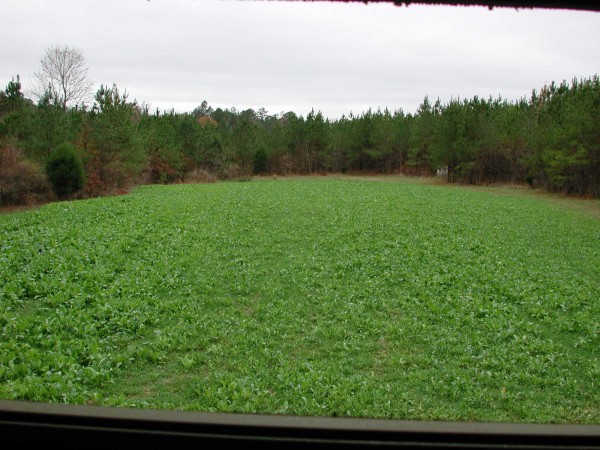
Working this property reminded me that hungry deer are easy to hunt. This is not a new principle. A very successful hunting strategy is to determine a limiting resource (food, cover, or water) and when deer are using that limiting resource. In this case, food was clearly the limiting resource. There were miles and miles of closed canopy pines (both private and industrial owned) and a few interspersed fescue pastures. There were no row crops or other cultivated crops within the likely range of a deer. Hence the primary source of quality and palatable food were the plots on my client’s property. Hence my client knows exactly where to hunt. From experience, he had learned how to approach each plot based on the predicted wind direction to limit disturbance to the local deer herd. As a result he reported seeing multiple deer almost every time he went hunting.
Because he had identified the limited resource and how to hunt it without disturbing deer, he and his guests have been extremely successful at observing and harvesting deer. I warned him that after he implements the habitat improvements I recommended, the quality of the deer should increase, but the quality of his hunting, measured by number of deer observed, may decrease.
I created a plan to thin the timber significantly so there would be sunshine reaching the forest floor. This action paired with a treatment of herbicide and prescribed fire to control hardwood saplings should result in a huge increase in the quality and quantity of native browse production. This means there will be quality food throughout the property, not just in the food plots. In addition, my plan included significantly increasing the acres of food plots and changing what he planted from solely winter annuals to forage soybeans during the summer and winter annuals during the fall (if the deer consumed the beans before they produced pods). It may take a season or two to get the deer density/forage production ratio balanced.
I’m extremely confident if he implements my habitat recommendations, the herd’s quality will increase. However, I’m not sure his observation rate will increase. We will use a trail camera survey to monitor the herd’s population trends. However, monitoring the satisfaction of the client will be through direct observation and conversation. I was confident in my proposal based on detailed and repeated conversations about his deer management and hunting goals and objectives. It is critical to listen to their objectives. Listening often allows me to give the best counsel.
Growing Deer together,
Grant
The Shift
How come I see so many bucks in late summer and as soon as bow season starts I don’t see any of those bucks? Dusty
Dusty,
There are bucks at my place that do that also. One buck in particular at The Proving Grounds hits the road just after velvet shedding each fall. Again this fall, for the 3rd year in a row, one of our oldest bucks disappeared after feeding on my soybeans all summer long. As in past years, he will probably become a resident again in the spring and summer. This can be a challenging situation.
GPS collared bucks tell us that bucks often have a slight shift or even an entire shift between their summer and winter ranges. We’re not sure why it happens but every buck has its own personality and movement patterns.
Growing Deer together,
Grant
Protecting the future of hunting – one coyote at a time
Last Saturday morning was very cold and windy at The Proving Grounds. It had been unseasonably cold for days so I assumed the deer would be feeding late into the morning. I had selected a stand about 100 yards from a bedding area in hopes of observing deer returning to cover. I was able to approach the stand with the strong wind in my face and the set-up seemed ideal. The wind was shaking the tree, even though my stand was located in a bottom. I rarely hunt the bottoms at The Proving Grounds unless the wind is howling as other conditions tend to allow the wind to swirl. Swirling wind was a non issue last Saturday. Keeping my balance while riding (versus standing in) the stand was an issue.
During the late morning I spotted a coyote moving about 50 yards away. Recent research is clear that coyotes consume lots of fawns. Many times folks state that only a few coyotes actually kill deer. However, research from South Carolina clearly showed that a vast majority of fawns that were killed by coyotes were killed by different individuals (the wonders of genetics in research). Therefore, I consider each coyote a potential fawn and turkey killer. Coyotes also harass and kill adult deer. I wonder how many hunts I’ve had where deer I had patterned changed their travel to avoid coyotes.
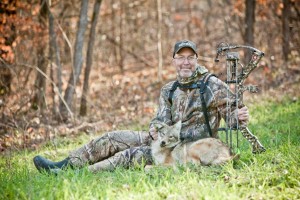 For those and other considerations, I instantly began squeaking (sucking air through tight lips) when I saw the coyote. The cameraman began filming and I readied the Z7. It was only seconds between when I first saw the coyote and when my arrow hit the mark. The first step of making a nice coyote pelt had been completed. I never worry about spooking deer during a hunt when shooting a coyote. Rather I consider the fawns, poults, and adult deer I’m a bit more likely to encounter during the future because I opted to take the shot. What will you do the next time you see a coyote while deer hunting?
For those and other considerations, I instantly began squeaking (sucking air through tight lips) when I saw the coyote. The cameraman began filming and I readied the Z7. It was only seconds between when I first saw the coyote and when my arrow hit the mark. The first step of making a nice coyote pelt had been completed. I never worry about spooking deer during a hunt when shooting a coyote. Rather I consider the fawns, poults, and adult deer I’m a bit more likely to encounter during the future because I opted to take the shot. What will you do the next time you see a coyote while deer hunting?
Growing Deer together,
Grant
Hunting Food Sources
This morning was the coldest morning of the 2010-11 season to date. There is a bit of ice in the trees, and the wind chill is in the teens. These are great conditions to hunt food sources or travel routes to food sources! There was a large acorn crop this year at The Proving Grounds, so most of the treestands I hunted during the pre-rut and rut were in the woods and not overlooking or near food plots.
That means that deer at The Proving Grounds don’t currently associate the food plots with danger! This combined with the cold temperatures expected during the next week should produce some great hunting opportunities!!
Deer must consume a huge amount of calories to stay warm when the temperatures are at or below normal during the winter in the middle to higher latitudes (this is one advantage of hunting the Midwest or North compared to the South). Deer, including mature bucks, will readily feed during the daylight in quality food plots that they don’t associate with danger.
This is one reason why it is critical to limit disturbance not only at, but around food sources. Deer can easily be conditioned to feed at night if they feel threatened in such areas during the day. To reduce the chances of conditioning deer to avoid food plots during prime hunting hours I only check trail cameras, etc., during the middle of the day and when the temperatures are warmer than normal during the winter. I also am extremely conscious of wind direction and the scent cone I produce when approaching the food plot and my stand location.
In the mornings, I tend to hunt travel corridors that I suspect mature bucks will use while returning from a food source to a bedding area. This is because it is very difficult to approach fields in the morning and not spook deer since they are likely to be in or bedding very near the food source throughout the night. An exception to this seems to be on mornings when it is 10 degrees or more colder than normal. Deer tend to bed in areas of maximum thermal protection during such nights. Since they haven’t fed and used a lot of fuel to keep their furnace going all night, they will be very hungry once the temperatures increase a bit. These conditions offer an opportunity to approach a food source early in the morning without being detected for some great mid morning hunting!
The afternoons offer a great opportunity to hunt at or along travels routes to food sources. Deer will typically be bedded during the early afternoon and allow stealthy hunters a great opportunity to sneak to their stand locations.
The best tool to hunting mature bucks during cold weather is knowing where the preferred food sources are that deer don’t associate with danger and only hunt them when they can be approached without alerting deer to your presence. Cold weather, especially extended periods of cold weather, can provide fabulous opportunities to hunt mature bucks!
Growing Deer together,
Grant
Boone and Crocket Experience
It getting cold and the rut is in full swing in most of the whitetails’ range. There have probably been thousands of articles written about hunting the rut. However, as deer herds have changed so should the hunting techniques. There are probably more mature bucks throughout the whitetails’ range now than ever. Mature bucks behave and influence the behavior of other deer differently than yearling bucks – what most of us grew up hunting. Deer herd population dynamics have changed, and so has the recruitment of new hunters. That’s one reason why I’m so proud of Liam Story and his father Jared.
Liam and Jared joined my family for the opening day of rifle season at The Proving Grounds. Liam is an avid football player and fan. Saturday is football day for many young men. However, Liam opted to join his Dad for some time in a ground blind. Liam remained patient and was rewarded with the opportunity to harvest his first deer!! Liam made a great shot with a youth model .243 loaded with a Barnes bullet and the 112 pound buck never took another step.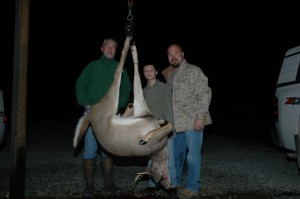
It was a Boone and Crocket experience for all involved! Liam’s mom joined us for pictures. I helped debone the deer and was blessed to hear Liam share the details of his hunt.
Why am I so excited about Liam’s hunt? Because it is becoming rare that youth are opting to go hunting rather than participate in any of the gads of other forms of activities. I’m a huge believer that many extremely valuable lessons can be learned while hunting. Liam and his father clearly shared an event that neither of them will ever forget. Liam’s success was a great motivation for him to want to hunt again. The meals their family will share from Liam’s buck will be another reinforcement to the quality experience that can’t be duplicated by most other activities.
Deer herds throughout much of the whitetails range are changing for the better. Unfortunately, the number of hunters joining our ranks has been decreasing for years. Good deer herds are managed by good hunters. If you haven’t been blessed by helping a new hunter, then get off the couch.
Growing Deer (and new hunters) together,
Grant
Lessons from a Mature Buck
Monday of this week, Jessica Brooks of Barnes bullets harvested one of the hit list bucks, Large Left 10, at The Proving Grounds.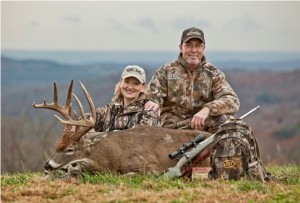 Jessica made a great shot (85 yards at 30 degrees downhill) and the Barnes VOR-TX bullet literally dropped the deer faster than my eyes could follow. She shot Left Brow Taller 10 at 1:30 PM. It was a thrilling hunt that included several lessons.
Jessica made a great shot (85 yards at 30 degrees downhill) and the Barnes VOR-TX bullet literally dropped the deer faster than my eyes could follow. She shot Left Brow Taller 10 at 1:30 PM. It was a thrilling hunt that included several lessons.
I had a lot of history with the buck that Jessica killed. He had the typical race horse appearance as a three year old. He appeared very muscular and spent a lot of time cruising. It seemed he was aggressive. We were blessed to find both of his sheds from last year and they scored 146”. They were the product of a great growing season (the right amount of rain when it was needed).
As a four year old his body had filled out more. His body was larger, but not as toned in appearance (like most men change from 30 to 40 years of age). His rack was larger also, especially noticeable in more mass! His gross score was 153. That’s about a 4.8% increase. However, that increase occurred during a year with a horrible drought during the growing season. There was no rain for 15 weeks at The Proving Grounds this summer! Any increase from 2009 to 2010 is huge! Certainly it could have been more, but most deer managers must work with what the environmental conditions are.

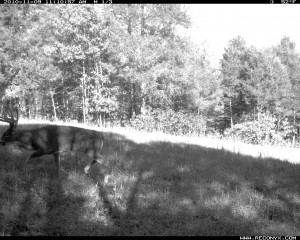
I had more than 30 Reconyx images of Large Left 10 since September 15th. However, most of them occurred once the rutting action began. In fact, during three weeks since September 15th I didn’t capture a single image of Large Left 10. My Reconyx units captured more images of Large Left 10 than any other of our 20 hit list bucks. His personality was to move, and movers are easier to harvest. Individual bucks have individual personalities. Large Left was aggressive and aggressive deer can be harvested.
Large Left 10 provided me with much enjoyment and several lessons including:
- Most bucks continue to increase in antler size until old age – older than they usually live in wild. If you wish to harvest bucks with larger antlers, you must pass younger bucks.
- Some bucks’ personality is to travel more than others and movers are relatively easy to harvest.
- During the rut, locations between feeding and bedding areas that allow a M.D.E. (Minimal Disturbance Entry) are prime locations. Jessica’s stand was on the edge of a power line that bisects a sanctuary with a feeding area (large food plot with standing Eagle Seed beans) to the east and a bedding area created by cutting trees and prescribed fire to the west. We were able to park on the ridge, walk down 100 yards and have a 400 yard view to the valley. We approached the stand about 9:00 AM and the wind currents were predominately rising so our scent was being carried up hill. The wind was swirling some, but because of the warming air during the morning, when the wind swirled the other way, the leaves were still rising.
- Patience and readiness are critical when hunting mature bucks. Jessica and I observed a shooter buck at 300 yards – twice – earlier that day. However, the shot opportunity was not ideal. Jessica is a wise and experienced hunter and opted to pass on those opportunities. She’s practiced and capable to shoot accurately at 300 yards, but the buck was in tall grass and moving. Passing those opportunities yielded a great opportunity at 85 yards on a fabulous buck.
This was a great experience in the benefits of good herd and habitat management and good hunting skills. We knew this buck was in the area, that the stand location was ideal for the rut, and remaining on the stand through the midday had a great chance of yielding an opportunity to harvest a mature buck. Jessica had the discipline to pass on marginal opportunities and the skills and gear to capitalize on a great opportunity!
With discipline you can have the same opportunities at your Proving Grounds.
Growing Deer together,
Grant
The Importance of Food
Have you ever noticed how important food is to all critters? Bass fishermen concentrate their efforts on identifying what bass are feeding on that day in the area they are fishing. Many trout fishermen are even more tuned into what their prey is eating. They select flies based on what insects are hatching at that moment. This technique is called matching the hatch.
Deer hunters should pay just as much attention to the current food selections as trout fishermen. There are currently beautiful wheat food plots at The Proving Grounds. They are lush! However, I don’t believe deer have consumed one blade of the wheat yet this fall. The reason is there are currently plenty of acorns. If I selected a stand overlooking wheat last week, I’d would have only seen a deer if it was traveling through the food plots (based on Reconyx trail camera images). However, I harvested one of my hit list bucks by paying attention to what deer are currently consuming – acorns. Does are traveling to eat and mature bucks will be checking out the does.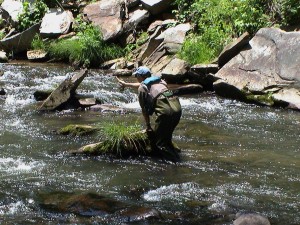
When I go trout fishing I see some insects buzzing along the water’s surface. I rarely catch my limit of mature trout. However, my buddies that are skilled trout fisherman recognize different species of insects and know which ones trout are most likely to strike. I approach deer hunting the same way. I’m most successful when I know what deer are most likely to consume and where they are finding that food source.
Just like the skilled fly fisherman that cast his fly between the overhang that is providing trout cover so they can approach the food, I wish to place my stand where deer are likely to travel while in route to the food. Knowing what food deer currently prefer and where they prefer to feed on that item is the key to hunting pre, during, and post rut. How you hunt the food source may vary (distance from cover, etc.) with the time of the year, but the knowledge required to understand the current preferred food doesn’t change.
Growing Deer together,
Grant
Grunt Call + Z7 = Success
I harvested a nice buck yesterday at The Proving Grounds. It was a thrilling hunt that included the buck grunting/balling, and then responding to my grunts by approaching my stand and actually walking a ¾ circle around me. It might have walked all the way around my stand looking for the source of the grunt he heard except the Z7 launched.
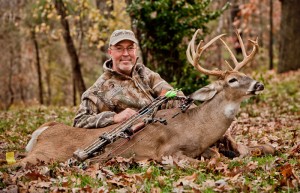 There’s much to be learned from that experience. Deer, and most wild animals, are excellent at determining the source of sound. The woods are rarely quiet as Hollywood portrays. There are small branches breaking and other common sounds that probably are not given much attention by mature bucks. Other sounds, such as metal clanking, etc., are not common and probably serve to alert deer.
There’s much to be learned from that experience. Deer, and most wild animals, are excellent at determining the source of sound. The woods are rarely quiet as Hollywood portrays. There are small branches breaking and other common sounds that probably are not given much attention by mature bucks. Other sounds, such as metal clanking, etc., are not common and probably serve to alert deer.
Bucks grunting are a normal and frequent sound in the woods this time of year, especially in areas where the deer herd has been managed to allow a substantial portion of the bucks to mature. Hence, grunt calls, as long as they are within the normal pitch and tone of real bucks’ sound, are commonly heard by deer during or just before the rut. Therefore, I use grunt calls extensively this time of year.
I prefer a call that produces a lot of volume. I will commonly look around to make sure there are no deer in view, then begin by grunting very softly. Loud grunts may alert deer that are close by and don’t expect a mature buck to be that close. If there is no response, I call again using more volume.
The second way I use a grunt call is to attempt to make deer I observe to approach closer to my stand. I simply judge how far the deer is from the stand, then call just loud enough so they can hear the call. I typically call softly and increase the volume until the buck acknowledges the call.
Don’t be scared to use a grunt call. This week throughout most of the whitetails’ range is a great time to use a grunt call. I use a homemade call that a friend gave me. It can produce a lot of volume and the tone is medium to deep. Grunt calls are one of my favorite tools to harvest mature bucks.
Growing Deer together,
Grant
Patterning Mature Bucks
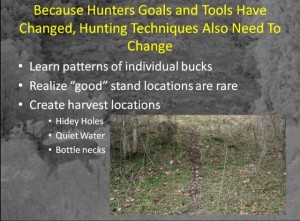 I’m getting ready for a seminar tonight at the First Baptist Church of Swedeborg. Attendees will learn the best techniques for Patterning Mature Bucks. I use Reconyx trail cameras because they provide great information with minimal disturbance.
I’m getting ready for a seminar tonight at the First Baptist Church of Swedeborg. Attendees will learn the best techniques for Patterning Mature Bucks. I use Reconyx trail cameras because they provide great information with minimal disturbance.
Growing Deer together,
Grant



